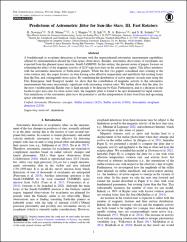| dc.contributor.author | Sowmya, K. | |
| dc.contributor.author | Nemec, N. E. | |
| dc.contributor.author | Shapiro, A., I. | |
| dc.contributor.author | Işık, Emre | |
| dc.contributor.author | Krivova, N. A. | |
| dc.contributor.author | Solanki, S. K. | |
| dc.date.accessioned | 2022-11-10T08:24:31Z | |
| dc.date.available | 2022-11-10T08:24:31Z | |
| dc.date.issued | 2022 | en_US |
| dc.identifier.citation | Sowmya, K., Nèmec, N. E., Shapiro, A. I., Işık, E., Krivova, N. A., & Solanki, S. K. (2022). Predictions of Astrometric Jitter for Sun-like Stars. III. Fast Rotators. The Astrophysical Journal, 934(2), 146. | en_US |
| dc.identifier.uri | https://hdl.handle.net/20.500.12846/680 | |
| dc.description.abstract | A breakthrough in exoplanet detections is foreseen with the unprecedented astrometric measurement capabilities offered by instrumentation aboard the Gaia space observatory. Besides, astrometric discoveries of exoplanets are expected from the planned space mission, Small-JASMINE. In this setting, the present series of papers focuses on estimating the effect of the magnetic activity of G2V-type host stars on the astrometric signal. This effect interferes with the astrometric detections of Earth-mass planets. While the first two papers considered stars rotating at the solar rotation rate, this paper focuses on stars having solar effective temperature and metallicity but rotating faster than the Sun, and consequently more active. By simulating the distribution of active regions on such stars using the Flux Emergence And Transport model, we show that the contribution of magnetic activity to the astrometric measurements becomes increasingly significant with increasing rotation rates. We further show that the jitter for the most variable periodic Kepler stars is high enough to be detected by Gaia. Furthermore, due to a decrease in the facula-to-spot area ratio for more active stars, the magnetic jitter is found to be spot dominated for rapid rotators. Our simulations of the astrometric jitter have the potential to aid the interpretation of data from Gaia and upcoming space astrometry missions. | en_US |
| dc.language.iso | eng | en_US |
| dc.publisher | IOP Publishing | en_US |
| dc.relation.isversionof | 10.3847/1538-4357/ac79b3 | en_US |
| dc.rights | info:eu-repo/semantics/openAccess | en_US |
| dc.subject | Main-Sequence Stars | en_US |
| dc.subject | Solar | en_US |
| dc.subject | Variability | en_US |
| dc.subject | Magnetism | en_US |
| dc.subject | Faculae | en_US |
| dc.subject | Ana Dizi Yıldızları | en_US |
| dc.subject | Güneş Enerjisi | en_US |
| dc.subject | Manyetizma | en_US |
| dc.subject | Sterne der Hauptreihenfolge | en_US |
| dc.subject | Sonne | en_US |
| dc.subject | Veränderlichkeit | en_US |
| dc.title | Predictions of astrometric jitter for sunlike stars. III. Fast Rotators | en_US |
| dc.type | article | en_US |
| dc.relation.journal | The Astrophysical Journal | en_US |
| dc.identifier.volume | 934 | en_US |
| dc.identifier.issue | 2 | en_US |
| dc.relation.publicationcategory | Makale - Uluslararası Hakemli Dergi - Kurum Öğretim Elemanı | en_US |
| dc.contributor.department | TAÜ, Mühendislik Fakültesi, Bilgisayar Mühendisliği Bölümü | en_US |
| dc.contributor.institutionauthor | Işık, Emre | |
| dc.identifier.wosquality | Q1 | en_US |
| dc.identifier.wos | WOS:000835052000001 | en_US |

















